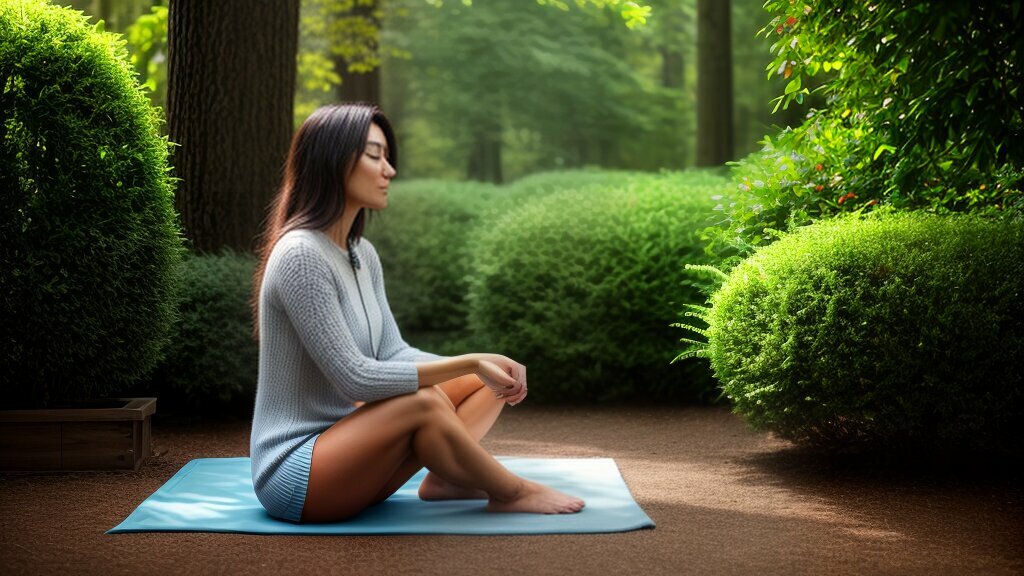Welcome to the world of mindfulness meditation! If you’re new to meditation, you may be wondering where to start. You may have heard about the benefits of mindfulness, such as reduced stress, improved focus, and better sleep, and you’re ready to give it a try. In this article, we’ll explore the basics of mindfulness meditation for beginners practices and provide you with tips and techniques to help you start your journey towards a more peaceful and present life.
Key Takeaways:
- Starting your mindfulness journey is important for reducing stress and improving focus.
- Becoming mindful means focusing on the present moment and observing thoughts without judgment.
- In this article, we’ll guide you through techniques to start practicing mindfulness meditation.
Understanding Mindfulness Meditation Techniques for Beginners
Are you feeling overwhelmed, stressed, or anxious? Are you looking for a way to refine your focus, enhance your mental clarity, and improve your emotional well-being? If so, starting a mindfulness meditation practice may be just what you need.
Mindfulness meditation is a practice that involves paying attention to the present moment without judgment. By focusing on your breath, body sensations, and thoughts, you can cultivate a state of mindfulness, which can have numerous benefits for your physical and mental health.
If you’re a beginner, it’s important to start with simple mindfulness meditation techniques that you can build upon over time. One of the easiest ways to practice mindfulness is to simply focus on your breath. Find a quiet place where you won’t be disturbed and sit or lie down comfortably. Close your eyes and take a deep breath in through your nose, then slowly exhale through your mouth. Repeat this process several times, focusing your attention on the sensation of your breath moving in and out of your body.
Another technique for beginners is to do a body scan meditation. This involves focusing your attention on different parts of your body, starting from your toes and moving up towards your head. As you focus on each part of your body, notice any sensations or feelings that arise without judgment, and then move on to the next part of your body.
Remember, mindfulness meditation is a practice, and like any skill, it takes time and consistency to develop. So, be patient with yourself and start with short meditation sessions of just 5-10 minutes per day. As you become more comfortable with the practice, you can gradually increase the length of your sessions.

There are many different mindfulness meditation techniques for beginners to try, and it’s important to find the ones that work best for you. Some people prefer to practice mindfulness while walking, while others find it helpful to do it while eating or doing other everyday activities. The key is to find a technique that you enjoy and can sustain over time.
By incorporating mindfulness meditation into your daily routine, you can experience numerous benefits, including reduced stress, improved mental clarity, and enhanced emotional well-being. So why not start your mindfulness journey today?
Getting Started with Mindfulness Meditation: A Beginner’s Guide
To begin your mindfulness meditation practice, it is crucial to create an environment that is conducive to relaxation and focus. Find a quiet and comfortable space where you won’t be disturbed. Wear loose and comfortable clothing, and remove any distractions such as phones or laptops. You can also use scents that promote relaxation and calmness, such as lavender or sandalwood, to enhance your meditation experience.
Next, establish a comfortable posture that allows you to sit with a straight back and relaxed shoulders. You can sit on a chair or cushion, whichever works best for you. Place your hands on your lap or knees, and gently close your eyes or lower your gaze.
Take a few deep breaths, inhaling through your nose and exhaling through your mouth. Once you feel relaxed, turn your attention to your breath and observe it without judgment. Focus on the sensations of your breath as it enters and leaves your body. If your mind starts to wander, gently bring your attention back to your breath.
Try These Mindfulness Exercises:
| Exercise | Description |
|---|---|
| Body Scan Meditation | Lie down on your back or sit in a comfortable position and close your eyes. Focus on each part of your body, starting from your toes and moving up to your head. Observe any physical sensations or discomfort that you may be experiencing. |
| Mindful Breathing | Take slow deep breaths, inhaling and exhaling through your nose. Focus your attention on the sensation of your breath moving in and out of your body. Count each breath cycle up to ten, and then start again from one. |
| Walking Meditation | Choose a quiet place to walk, and walk at a slow pace. Focus on the movement of your feet and the sensations in your body as you walk. If your mind starts to wander, gently bring your attention back to your steps. |
Remember, the most important thing is to be patient with yourself. Starting a mindfulness meditation practice can be challenging, but it’s worth it. With consistent practice, you will start noticing the benefits of being present and aware in your everyday life.

Easy and Simple Mindfulness Meditation Exercises for Beginners
If you’re new to mindfulness meditation, it can be helpful to start with simple exercises that don’t require a lot of time or effort. Here are some easy and effective mindfulness meditation exercises for beginners:
Mindful Breathing
Mindful breathing is a simple but powerful exercise that helps you stay present and focused. Find a quiet place where you won’t be disturbed and sit comfortably with your back straight. Close your eyes and focus your attention on your breath as you inhale and exhale. Notice the sensation of your breath moving in and out of your body and try to keep your mind from wandering. If your mind starts to wander, gently bring your attention back to your breath.
Body Scan Meditation
Body scan meditation is a great way to tune into your body and release tension. Lie down on your back and close your eyes. Take a few deep breaths and focus your attention on your body. Starting at the top of your head, scan your body from head to toe and notice any sensations or areas of tension. As you become aware of each area, take a deep breath in, hold it for a few seconds, and then release it as you exhale.
Walking Meditation
Walking meditation is a great way to bring mindfulness into your daily routine. Find a quiet, safe place to walk and start by standing still and focusing on your breath. Begin to walk slowly and mindfully, paying attention to each step and the sensation of your feet touching the ground. If your mind starts to wander, gently bring your attention back to your breath and your steps.
Mindful Eating
Mindful eating is a simple exercise that can help you develop a more mindful approach to food. Choose a small piece of food, like a grape or a piece of chocolate, and examine it closely. Notice its colour, texture, and shape. Take a few deep breaths and then take a small bite. Notice the taste, texture, and sensation of the food in your mouth. Chew slowly and mindfully, focusing on the taste and texture of the food.

By practicing these simple mindfulness exercises regularly, you can start to cultivate a greater sense of awareness and mindfulness in your everyday life. Remember that mindfulness takes practice and patience, so be kind to yourself and keep at it.
Tips and Techniques for Successful Mindfulness Meditation Practice
To make the most of your mindfulness meditation practice, there are some tips and techniques you can use to ensure success. Here are some helpful strategies to try:
- Be consistent: Set aside time each day to practice mindfulness meditation. Even if it’s just five minutes, practicing every day will help you establish a routine and see progress over time.
- Set realistic expectations: Don’t expect immediate results. Mindfulness meditation is a long-term practice that requires patience and dedication. Start with small goals and celebrate your progress along the way.
- Find your style: Experiment with different types of mindfulness meditation to find what works best for you. Some people prefer guided meditations, while others prefer silent meditation.
- Limit distractions: Find a quiet space where you won’t be interrupted. Turn off your phone and other electronics that may distract you.
- Breathe deeply: Focusing on your breath is a key part of mindfulness meditation. Take deep, slow breaths and let your mind concentrate on the sensation of your breath moving in and out.
Remember that mindfulness meditation is a practice and it takes time to develop. Don’t worry about perfection or getting everything right the first time. If you find yourself struggling, don’t give up! Keep practicing and you will see progress.

“The present moment is the only moment available to us, and it is the door to all moments.” – Thich Nhat Hanh
Remember, mindfulness meditation is a powerful tool for reducing stress and increasing overall well-being. By incorporating these tips and techniques into your practice, you can make the most of your journey towards mindfulness.
Conclusion
Congratulations, you have taken the first step towards incorporating mindfulness meditation into your daily routine. By practicing mindfulness meditation, you can enjoy various benefits, including reduced stress and improved focus.
Remember, starting a meditation practice can be challenging, but with consistency and dedication, you can make significant progress. Do not worry if you experience difficulty in the beginning; with time, your practice will become more natural, and you will notice the positive changes in your life.
Take Action Today
Begin your mindfulness meditation practice by finding a quiet place, sitting comfortably, focusing on your breath, and observing your thoughts without judgment. Start with a few minutes each day and gradually increase your meditation time.
Utilize different mindfulness meditation techniques, such as body scan meditation and loving-kindness meditation, to find what works best for you. Incorporate mindfulness exercises into your daily routine, such as mindful eating and walking meditation, to cultivate mindfulness in everyday activities.
Remember, self-care is critical, and making time for meditation is a valuable investment in your overall well-being. Begin your mindfulness meditation journey today and enjoy the transformative benefits that it brings!
FAQ
Q: What is mindfulness meditation?
A: Mindfulness meditation is a practice that involves focusing your attention on the present moment and observing your thoughts and feelings without judgment.
Q: How can mindfulness meditation benefit beginners?
A: Mindfulness meditation offers numerous benefits for beginners, including reducing stress, improving focus and concentration, and promoting overall mental well-being.
Q: How do I start practicing mindfulness meditation?
A: To start practicing mindfulness meditation, find a quiet and comfortable space, sit in a relaxed posture, and focus on your breath or use guided meditation exercises to help you stay present.
Q: What are some easy mindfulness meditation exercises for beginners?
A: Beginners can try simple exercises like mindful breathing, body scan meditation, walking meditation, and mindful eating to incorporate mindfulness into their daily routines.
Q: What are some tips for a successful mindfulness meditation practice?
A: Consistency is key in mindfulness meditation. Set realistic expectations, find a meditation style that suits you, and practice patience. Dealing with distractions and overcoming challenges is also important for a successful practice.
